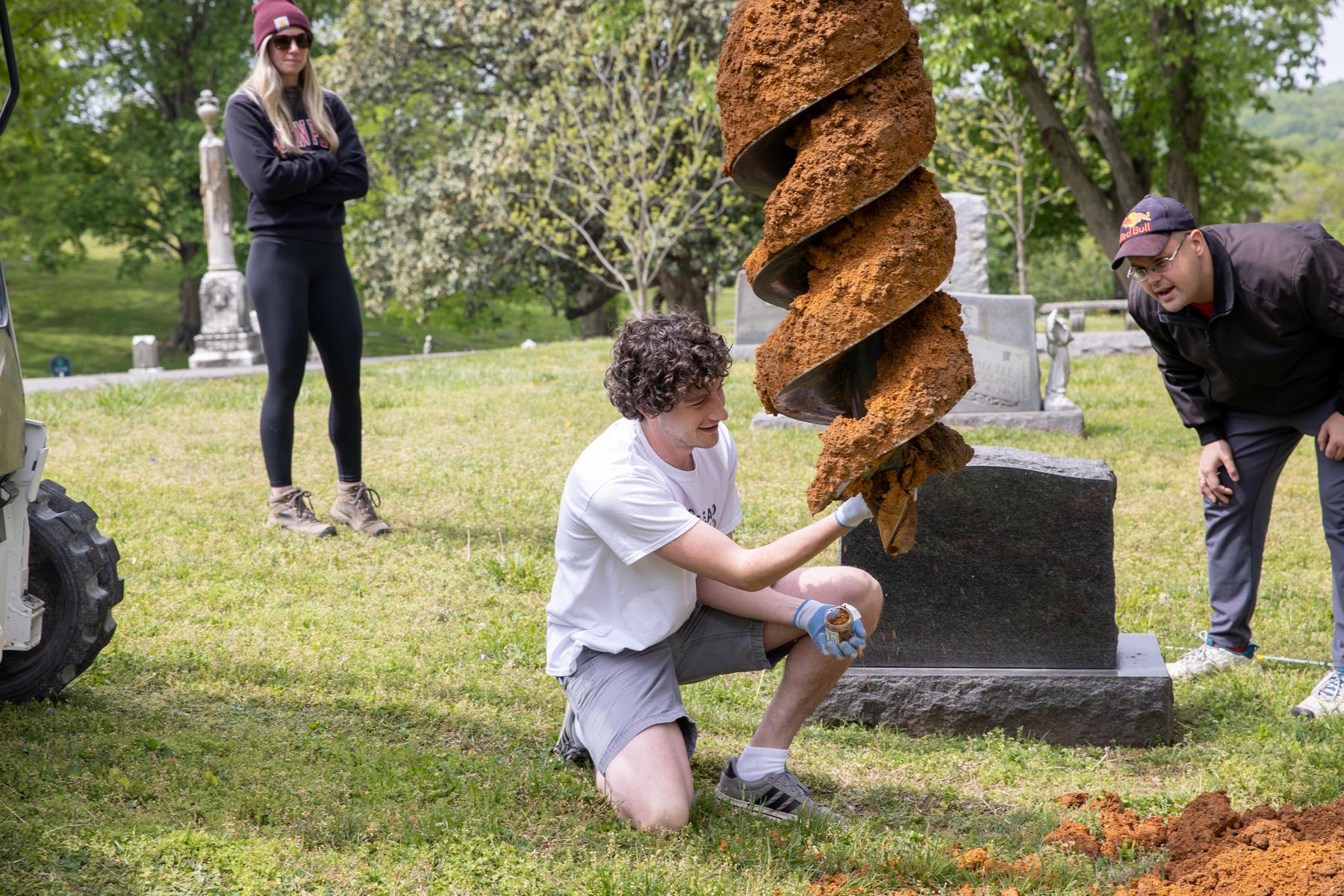APSU student researcher digs deep into cemetery waste's environmental impact
(Posted on Tuesday, May 9, 2023)
CLARKSVILLE, Tenn. - Patrick Richardson, a health and human performance major with a concentration in public health at Austin Peay State University, has always been fascinated with the environment’s role in community wellness, and in Spring 2023 he gained firsthand experience identifying contaminants through a student research grant.
Richardson spent the last semester of his junior year working with professors from three departments to survey and collect soil samples from Clarksville’s Riverview Cemetery. From there, the materials were sent to an environmental lab to test for formaldehyde leakage and heavy metals.
“One of the reasons that I’m particularly interested in this is because of something called the green burial movement,” Richardson said. “It’s this new outlook on how, particularly in Western culture, we interact with death and the funeral industry. Things like green burial composting are up and coming, and having more evidence about the impact of our traditional burial practices could help us understand how it impacts our health.”
According to Richardson, cemetery waste often comes from historical embalming methods or any metal pieces of caskets, such as hinges. Hazardous materials can then make their way into nearby groundwater or soil.
“We are going to [measure] formaldehyde concentration, which is an organic contaminant,” said Dr. Joao Antonangelo, assistant professor of soil fertility and soil chemistry. “And arsenic contamination as well, which is a metalloid that causes cancer.”
Dr. Heather Tillewein, assistant professor of public health and the project’s faculty adviser, said the goal is to determine the possibility of humans consuming hazardous materials from the cemetery via waterways or livestock.
“That’s why we’re collecting samples from graves of different eras, since embalming standards have changed throughout our history,” she said. “Then we’re going to go downstream and do a groundwater analysis on that type of soil to see if there’s any chance that’s what’s up here, these contaminants could potentially impact downstream.”
Richardson said the group collected eight soil samples from six gravesites dated between 1928 and 2000, with roughly 10 years between each one. He chose Riverview Cemetery because of the high number of gravesites and proximity to the Cumberland River.
After marking out several plots for sampling, the team brought in a Ground Penetrating Radar (GPR) to locate any caskets before collecting soil.
“The idea is for them to go in and collect their soil samples without drilling a hole through somebody’s grave,” said Dr. Daniel Frederick, professor of geology, who operated the GPR. “The other concern is that, particularly in Riverview Cemetery, there are a significant number of unmarked graves … we don’t want to go in somewhere we think is fine because there’s no marker and find out there’s actually a grave there.”
GPR uses radar waves to detect changes in density below the ground’s surface, then creates an image map representing those differences. Caskets are traditionally buried 6 feet underground, and Frederick said he was able to pick up signals down to nearly 10 feet.
“It works just like glass and reflection,” Frederick said. “Any time a wave goes through from one density to another, a certain amount of energy is reflected back off, and then a certain amount is bent as it goes through the frame. In looking for graves, if the casket’s in good shape and they have a concrete vault it’s going to give you a strong signal. Particularly if you have a metal casket, that’s a huge density different and you’re going to get a lot of energy reflected.”
Richardson assisted Frederick with the GPR process, and he said it was one of many practical skills he learned while working on his research project.
“I’m certainly the unskilled labor here,” Richardson said. “This is going to help me to gain knowledge of the different facets of environmental health, and in the process as a whole I’ve gotten experience with grant writing, how the application process works and putting an abstract together.”
The team has also submitted an abstract to the American Public Health Association (APHA) and could be asked to present their findings at the APHA Annual Conference once the research is complete.
“We’re going to submit the soil samples to an environmental lab in Kentucky, which is the closest one here,” Tillewein said. “They’ll send us back the data analysis for the soil samples, and then we can start writing reports.”
Richardson hopes his research project will add to the larger pool of knowledge on cemetery waste, and he said the support he received from across the University made it possible.
“There are a lot of facets to public health, and Austin Peay provides great opportunities like internships and student research grants for you to get hands-on experience and find out what you want to do,” he said. “I’m very thankful for all the people who are giving their time and energy to this.”


